

SAVING NORTH CENTRAL TEXAS
2023-2024
SAVING NORTH CENTRAL TEXAS
Saving North Central Texas 2023-2024 provides an overview of Preservation Texas’s Most Endangered Places listings in the North Central Texas region, as well as useful information about Preservation Texas and how you can work to protect cultural and historic sites where you live.
1.0 / ABOUT PRESERVATION TEXAS
Preservation Texas is a private, 501(c)(3) nonprofit organization, founded in 1985 and headquartered in San Marcos. The organization receives no public funding and relies on membership dues, grants and donations for its work. A volunteer Board of Directors, drawn from a range of professional and community backgrounds governs the organization and provides direction to staff.
• The chartered purposes of the organization are broad and intended to enable a range of preservation activities:
• To serve as an auxiliary to all agencies of the State of Texas concerned with our history, heritage, and the preservation and maintenance of significant areas, sites, buildings, monuments and artifacts;
• To acquire, by purchase, gift, devise or bequest, with or without restriction, and to preserve, restore, maintain and present to the public those areas, sites, buildings, monuments, artifacts, documents, and objects which are significant in the history, prehistory, archaeology, architecture, heritage and culture of Texas;
• To disseminate knowledge of the history, prehistory, heritage and culture of Texas;
• To engage in historical and archaeological research on the activities of past Texans; and
• To foster, encourage and develop a general appreciation and understanding of the
accomplishments of past generations of Texans in order that the lives of present and future generations may be enriched.
The organization fulfills its mission through (A) Legislative Advocacy by alerting its members to important legislation being considered by the State of Texas and providing written and oral testimony at bill hearings; (B) Local Advocacy by intervening on behalf of local stakeholders who ask for support from Preservation Texas;
(C) Educational Programs such as the biennial Preservation Day at the Capitol and regional symposia on historic preservation topics; (D) Honor Awards that recognize outstanding preservation efforts to save Texas’ Most Endangered Places; and (E) Preservation Texas’s signature Most Endangered Places program, begun in 2004; more about this program will follow (Section 6.0).
Preservation Texas also owns Bassett Farms Conservancy, a 2,400-acre working cattle ranch and former cotton farm located southeast of Waco in Falls and Limestone counties. The Conservancy is being developed as a preservation and conservation training center and retreat. Founded in 1871, the farm and ranch was bequeathed to Preservation Texas in 2011 by the late Mrs. Willie Ford (Bassett) Sparkman, and includes a range of historic, cultural and natural resources. Programs will focus on developing historic preservation skills, while the property is to be managed with a focus on cultural landscape preservation.
2.0 / PROTECTING HISTORIC PLACES
This section provides an overview of programs and resources that can be useful in protecting historic places.

SAVING NORTH CENTRAL TEXAS 2023-2024 PRESERVATION TEXAS Page 1
Cover: The Outlaw Station, a petrified wood filling station in Glen Rose (Somervell County)
2.1 / Historic Designations
Historic places may be officially recognized as historic by federal, state and local governments. These designations serve a range of purposes; some tied to incentives and some tied to regulations. Just because a site has not been designated does not mean that it lacks significance; more than likely, no effort has yet been made to recognize it as almost all such designations are initiated at the local level by property owners, advocates, historical societies, preservation organizations or historical commissions.
Efforts to save sites are often more successful when the buildings have federal- or statelevel designations. These designations give assurance to decision-makers, grant- funders and the general public that a site has welldocumented significance. Therefore, a plan to secure designation should be put in place for any endangered resource that is not yet designated.
The regulatory effects of designation vary. Federal designation provides no regulatory oversight of historic places; state designation provides a range of limited (Recorded Texas Historic Landmarks) to strong (State Antiquities Landmarks) oversight. Maximum oversight is typically found at the local level through the designation of local landmarks and local historic districts, although some local ordinances are weak and ineffective.
TEXAS HISTORIC SITES ATLAS
The Texas Historical Commission’s Texas Historic Sites Atlas enables you to search for specific buildings and to see all of the sites recognized at the state and federal levels. Be sure to verify the information in the Atlas by contacting the Texas Historical Commission as no database is perfect. The website is: Atlas.THC.State.tx.us
FEDERAL DESIGNATIONS
The National Register of Historic Places was created in 1966 under the National Historic Preservation Act. The process begins with submission of a comprehensive nomination form to the Texas Historical Commission. The submitted form is then reviewed by the State Board of Review before being forwarded to the National Park Service for final approval. In Texas (2023) there are 3,615 listings on the National Register, of which 1,671 are Historic Districts.
National Register properties are evaluated for the quality of their significance and must possess integrity of location, design, setting, materials, workmanship, feeling and association. They must be associated with significant events or significant people, embody a distinctive architectural type, period, method of construction, the work of a master, artistic value, or be likely to yield important information in history or prehistory. Cemeteries, birthplaces, graves, commemorative properties and relocated structures are typically not listed, but there are exceptions.
Individually listed buildings and sites that are added to the National Register are classified as being of local, statewide or national significance. Typically, but not always, these buildings must be at least fifty years old. The Texas Historical Commission can assist in determining whether an unlisted building might be eligible for listing before a formal nomination is submitted.
Cohesive areas or neighborhoods may also be listed on the National Register as Historic Districts. A majority of the properties within a historic district must have historic significance and retain their historic character — such properties are known as contributing properties. Contributing properties are afforded the same grant opportunities and incentives as sites that are individually listed.

Page 2 SAVING NORTH CENTRAL TEXAS 2023-2024
PRESERVATION TEXAS
PRESERVATION TEXAS
For a site of exceptional significance, the National Park Service will very selectively consider nominations for its designation as a National Historic Landmark, a specific category that recognizes sites of special importance to all Americans. Thus the use of the phrases “listed on the National Register” and “historic landmark” are not interchangeable. Federal programs treat National Historic Landmarks somewhat differently because of their status, including greater protection if a federal project threatens to impact the site, or access to grants such as the Save America’s Treasures grant program.
Federal designation comes with no regulatory oversight by the federal government. The National Park Service plays no direct role in the planning, management or any other decision-making related to sites listed on the National Register of Historic Places. However, sites listed on the National Register or contributing to a National Register Historic District may be eligible for the 20% rehabilitation tax credit.
STATE DESIGNATIONS
The Texas Historical Commission reviews and approves nominations for buildings to be designated as Recorded Texas Historic Landmarks (RTHLs). These Landmarks must be at least fifty years of age or older and retain architectural integrity. Buildings cannot become RTHLs if historic features are obscured by nonhistoric materials, such as vinyl siding, or if they have been relocated within the last fifty years.
Nominations are submitted through the local County Historical Commission. Sites that are designated as RTHLs are recognized with Official Texas Historical Markers. It should be noted, however, that just because a building or site has a state marker does not mean that it is an RTHL. There are over 16,000 Official Texas Historical Markers; of those only about 3,800
are RTHLs. If a building or site is an RTHL, its marker should have “Recorded Texas Historic Landmark” stamped at the bottom.
A limited amount of protection is afforded by the RTHL designation. The historic or architectural integrity of an RTHL shall not be altered without notifying the Texas Historical Commission at least 60 days in advance. Interiors are not regulated unless the changes impact the exterior or the structural integrity of the building.
State Antiquities Landmarks (SALs) are designated by the Texas Historical Commission and are protected under the Antiquities Code of Texas. Any building listed on the National Register that is located on non-federal public land (state, county, or city) is eligible for designation. Sites can be nominated by any group or individual, and are considered by the Antiquities Advisory Board before a final vote by the Texas Historical Commission.
The SAL designation is the most restrictive state-level designation available as it requires the property owner to consult with the Commission to determine if proposed alterations or demolition can occur. Archaeological sites may also be designated as SALs but do not need to be listed on the National Register.
The Historic Texas Cemeteries program began in 1998. Cemeteries receiving this designation are protected by a record of their boundaries in county deeds and future owners of adjoining land are alerted of its existence. However, the designation provides no regulatory oversight over the property. Other state laws govern the handling of human remains and cemeteries in Texas. Historic Texas Cemetery designation is required before applying for an Official Texas Historical Marker for a cemetery.

SAVING NORTH CENTRAL TEXAS 2023-2024
Page 3
PRESERVATION TEXAS
LOCAL LANDMARKS AND DISTRICTS
State law enables local governments to create local historic districts. These are typically, but not always, accomplished through zoning amendments, creating provisions that govern alteration and potential demolition of local landmarks as well as new construction within locally designated historic districts. There is no standard set of regulations or guidelines in use statewide. While many local preservation ordinances are similar, each one is tailored to suit the needs and objectives of the community. Some communities are better than others in making information about local landmarks and historic districts available online; be sure to contact the local preservation or planning official for current information about landmarks, historic district boundaries, and relevant regulations.
2.2 / Preservation Guidelines
The Secretary of the Interior’s Standards are applied to almost every decision made at the federal, state and local level relative to proposed physical changes to a historic place. These Standards were established in 1977 by the National Park Service under the authority of the United States Secretary of the Interior and provide guidelines for Preservation (maintaining a structure as found); Restoration (uncovering, protecting and recreating features that would have been present during a specific period of significance); Rehabilitation (protecting key character-defining features while modifying other parts of the structure for contemporary uses); and Reconstruction (rebuilding a known, lost historic structure using extensive historical documentation).
Museum properties and exceptionally unique structures are typically preserved or restored; buildings that are being put to new uses or that have lost much of their historic integrity
are generally rehabilitated. Historically accurate reconstructions are uncommon and usually only undertaken for museum sites or minor outbuildings on private property. The standards encourage new construction to reflect contemporary aesthetics using compatible materials, form and scale.
Information about the Standards as well as Guidelines for the Treatment of Cultural Landscapes can be found at: NPS.gov/TPS/ Standards.htm
2.3 / Preservation Briefs
The National Park Service has published fifty Preservation Briefs that are available online at: NPS.gov/orgs/1739/preservation-briefs.htm . These briefs cover a range of specific topics from Repointing Mortar Joints in Historic Masonry Buildings (Brief #2) to Preserving Grave Markers in Historic Cemeteries (Brief #48). These technical briefs provide excellent illustrated examples to better inform property stewards about best practices.
3.0 / PRESERVATION TAX INCENTIVES
Financial incentives are available at the federal, state and sometimes local level for historic preservation.
3.1 / Federal Tax Incentives
Federal historic preservation incentives are managed by the National Park Service in partnership with the Texas Historical Commission. Information can be found at: NPS.gov/subjects/taxincentives/index.htm.
A summary of these federal incentives follows.
Income-producing historic buildings that are certified by the National Park Service as historic structures (typically those listed on the National

Page 4 SAVING NORTH CENTRAL TEXAS 2023-2024
Register of Historic Places) are eligible for a 20% income tax credit based on the qualifying costs of the project. Eligible properties include commercial, industrial, agricultural or residential rental properties.
The charitable donation of a historic preservation easement to a qualifying organization such as Preservation Texas provides additional tax benefits. An easement permanently protects a structure and its site by prohibiting changes to the exterior (and in some cases interior) features and by restricting land uses. These restrictions are voluntary and negotiated between the landowner and the donee organization within federal guidelines. The value of the donation is determined by a professional appraiser who considers the potential reduction of the market value of the property after the imposition of these voluntary restrictions.
Rehabilitations of large historic structures often make use of a combination of the 20% tax credit and the Low-Income Housing Tax Credit (LIHTC). The LIHTC is approximately 9% of the project cost, and provides an incentive for the creation of affordable rental housing for lowincome households.
3.2 / State Tax Incentives
The Texas Historic Preservation Tax Credit became effective in 2015. It provides for a tax credit of 25% of qualifying project costs for the rehabilitation of buildings listed on the National Register of Historic Places, as Recorded Texas Historic Landmarks or as State Antiquities Landmarks. Only buildings are eligible, and they must be used for income-producing or non-profit purposes.
Government-owned structures do not qualify unless they have been leased, typically to a nonprofit organization for an extended term. Non-
profit organizations, despite not paying taxes, can sell their state tax credit. For example, a $100,000 church restoration may result in a $25,000 tax credit that can be sold by the church to a Texas corporation that pays the state franchise tax or state insurance premium tax. Tax credit brokers may also purchase a credit. The dollar value of the credit is negotiated between the tax credit certificate holder and the purchaser, typically somewhat less than face value.
3.3 / Local Tax Incentives
Many local governments have adopted tax abatement or exemption programs to encourage the rehabilitation of historic structures, typically in historic downtown commercial districts managed by Main Street programs or in historic residential districts. Details about these local programs can be found by contacting the City Manager or similar official in the city in which a building is located. If your community does not yet have a local program, consider advocating for the establishment of such a program.
4.0 / PRESERVATION GRANT PROGRAMS
Federal, state and local historic designations for at-risk historic properties open the door to potential grants for restoration or rehabilitation. Grant funds are limited and highly competitive, and only significant historic places with urgent preservation needs are usually awarded these grants. A summary of grant programs follows.
4.1 / Federal Grant Programs
The most significant federal grant program is the Save America’s Treasures grant program. These grants are limited to National Historic Landmarks or buildings listed on the National Register of Historic Places at the national level of significance. Grants range from $125,000 to $500,000.

SAVING NORTH CENTRAL TEXAS 2023-2024 PRESERVATION TEXAS Page 5
PRESERVATION TEXAS
More widely used are Historic Preservation Fund grants, administered through the Texas Historical Commission’s Certified Local Government (CLG) program. These grants are available for historic resource surveys, National Register nominations, local preservation plans, local ordinance development or repairs in CLG communities. Grants range from $2,000 to $30,000. CLGs must meet federal standards with respect to their local preservation regulatory system; CLGs in North Central Texas are:
• Arlington (Tarrant Co.)
• Brown County
• Denton (Denton Co.)
• Denton County
• Fort Worth (Tarrant Co.)
• Glen Rose (Somervell Co.)
• Granbury (Hood Co.)
• Grapevine (Tarrant Co.)
• Mansfield (Tarrant Co.)
• Tarrant County
• Wichita Falls (Wichita Co.)
The Preserve America grant program remains authorized by Congress but in recent years has not received any federal funding. This grant program supported preservation planning activities in designated Preserve America communities. Preserve America communities in North Central Texas are:
• Abilene (Taylor Co.)
• Albany (Shackelford Co.)
• Celine (Denton Co.)
• Denton (Denton Co.)
• Electra (Wichita Co.)
• Frisco (Denton Co.)
• Granbury (Hood Co.)
• Grapevine (Tarrant Co.)
• Pilot Point (Denton Co.)
Some grant funding through the U.S. Department of Agriculture may be available for the rehabilitation of historic structures,
particularly those that will be used for community economic development purposes.
The National Endowment for the Arts and National Endowment for the Humanities will sometimes have grant opportunities that apply to historic structures being used for the arts or for museum purposes. Visit grants.gov for more information about federal grant opportunities.
4.2 / State Grant Programs
The Texas Historical Commission’s Texas Preservation Trust Fund supports historic site acquisition, survey, restoration, preservation, planning and heritage education relating to historic architecture and archaeological sites. These are competitive grants that can provide up to $30,000 in funding.
Preservation Texas played a leading role in the establishment of the Texas Historic Courthouse Preservation program. Since 1999, 74 historic county courthouses have received full restoration grants and another 29 have received emergency or planning grants (2023).
The competitive program is administered by the Texas Historical Commission. North Central Texas counties that have completed courthouse restorations through this program are:
• Archer County
• Bosque County
• Cooke County
• Denton County
• Erath County
• Hamilton County
• Hardeman County
• Hood County
• Johnson County
• Mills County
• Parker County
• Shackelford County
• Throckmorton County

Page 6 SAVING NORTH CENTRAL TEXAS 2023-2024
4.3 / Nonprofit and Foundation Grant Programs
Some nonprofit organizations and foundations offer grant opportunities that have been utilized to save endangered places in Texas.
The National Trust for Historic Preservation (SavingPlaces.org/grants) offers grants through its Preservation Fund; additional grant programs for historic African-American places and for Sacred Places have recently been initiated.
The Texas Historical Foundation ( TexasHistoricalFoundation.org ) provides grants of up to $5,000 that have been used for restoration projects. The Summerlee Foundation based in Dallas has also provided extensive grant funding for preservation projects across Texas. Regional community foundations are also an important source of donor-directed grants that might be available for historic preservation projects.
Historic structures in railroad communities have benefited from grants by the BNSF Railway Foundation (BNSFFoundation.org ) or the Union Pacific Foundation (UP.com) depending on which rail line operates in the community.
Grants for building materials for small projects have been awarded by the Home Depot; big box building supply stores will sometimes donate materials and equipment with a letter submitted to the store manager.
Financial institutions that serve the community often have grant programs. Some may be directed by local branch managers; others require application to the bank’s national headquarters.
5.0 / HISTORIC PRESERVATION AGENCIES AND ORGANIZATIONS
For many people working to save a historic place,
the role of different government agencies and organizations can be confusing. Each plays an important but specific role. Understanding what these agencies and organizations can (and can’t) do will help you chart a course for action.
5.1 / National Organizations
The National Park Service (NPS.gov) is the principal federal agency governing historic preservation programs. Most importantly, they oversee the National Register of Historic Places and the federal tax credit program.
The Advisory Council on Historic Preservation (ACHP.gov) is a small, independent federal agency that promotes historic preservation across the federal government. It advises the President and Congress on national preservation policy, with a special focus on implementation of the National Historic Preservation Act.
The National Trust for Historic Preservation (SavingPlaces.org ) is a private, non-profit organization that manages historic sites, intervenes in preservation lawsuits, manages the 11 Most Endangered List, and provides educational programming through its national conference. It is not a government agency and has no role in administering federal programs.
The national advocacy organization based in Washington, D.C. is Preservation Action (PreservationAction.org ), a 501(c)(4) nonprofit that works to develop historic preservation programs through advocacy for federal legislation in the U.S. Congress.
Another important organization is Partners for Sacred Places (SacredPlaces.org ), a nonprofit organization based in Philadelphia that supports stewardship of active congregations in older sacred places through capital campaign training and technical assistance.

SAVING NORTH CENTRAL TEXAS 2023-2024 PRESERVATION TEXAS Page 7
5.2 / State Organizations
The Texas Historical Commission ( THC. Texas.gov) is the state historic preservation office, based in Austin. As a state agency they administer state programs and act as a liaison for federal programs. With over 250 staff members, they provide assistance in a range of programs and also administer the state’s Main Street program.
Preservation Texas (PreservationTexas.org ) is the only statewide nonprofit historic preservation advocacy and education organization in Texas (Section 1.0).
5.3 / Local Organizations
Most Texas counties have established a County Historical Commission (CHC). These volunteer groups provide county-wide guidance to deliver educational programs, operate history museums, and advise the Texas Historical Commission on historic marker applications, for example. Some CHCs are very active while others meet infrequently. The local CHC can be an important resource, particularly when seeking historic designations.
Local governments that have adopted preservation ordinances usually establish a historic commission, landmark commission or similarly named committee of volunteers. These commissions administer local preservation programs, including local landmark designations, approval of historic building permits, and the development of preservation plans for the community.
Local non-profit preservation organizations operate independently of the government and typically support advocacy and educational programs. Each organization is different; some administer historic sites, some do not. Examples in North Central Texas include Historic Fort
Worth and the Abilene Preservation League. City-focused organizations often provide assistance to smaller communities within their counties.
6.0 / MOST ENDANGERED PLACES LIST
Established in 2004, Texas’s Most Endangered Places list is the signature program of Preservation Texas. Over the last eighteen years, over 170 sites and themes have been added to the list, of which less than 15 have been lost.
The list is designed to provide statewide publicity for important historic places at risk of imminent loss. Sites are nominated to Preservation Texas by its members and selections are announced annually. Preservation Texas provides advocacy and technical support for these places when requested by local advocates.
A list of North Central Texas sites that remain endangered follows.

Page 8 SAVING NORTH CENTRAL TEXAS 2023-2024
PRESERVATION TEXAS
NORTH CENTRAL TEXAS ENDANGERED PLACES
BOSQUE COUNTY
1884 WHIPPLE TRUSS BRIDGE
ADDRESS CR 3112 over the North Bosque River, Clifton
DESIGNATION RTHL
CONDITION Poor
OWNER Bosque County
RESOURCE TYPE Transportation
YEAR LISTED 2017
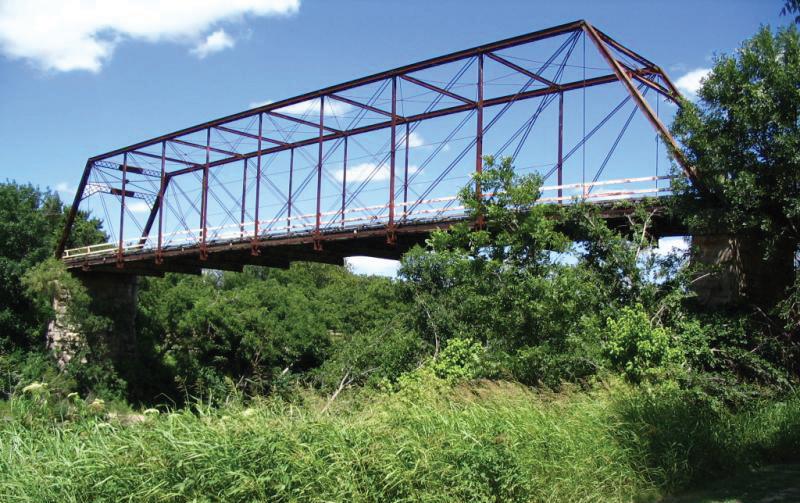
Built in 1884 by the Wrought Iron Bridge Company of Canton, Ohio, this bridge is one of the few remaining Whipple truss bridges in Texas. The bridge provided an important transportation connection from 1884 to 1941 when traffic was routed to the newly constructed Highway 6. In 2017, work commenced on the construction of a modern bridge 10 feet north of the old Whipple Truss bridge. Though the historic bridge has not been razed, it is now inaccessible.
ERATH COUNTY
BLUFF DALE BRIDGE
ADDRESS CR 149 over the Paluxy River, Bluff Dale
DESIGNATION NRHP, SAL
CONDITION Poor
OWNER Erath County
RESOURCE TYPE Transportation
YEAR LISTED 2009

Completed in 1891, the Bluff Dale Bridge is an exceedingly rare example of a nineteenth-century cable-stayed bridge. The bridge was built over the Paluxy River about halfway between Stephenville and Granbury and served as the principal river crossing until 1934. The bridge was officially closed to vehicular traffic in 1989, and has not been maintained in the years since. Today the Bluff Dale bridge is in an advanced state of deterioration.
HARDEMAN COUNTY QUANAH CITY PARK
ADDRESS 403 Good St, Quanah
DESIGNATION None
CONDITION Fair
OWNER City of Quanah
RESOURCE TYPE Municipal
YEAR LISTED 2021

Construction of Quanah City Park began as a W.P.A. project in November 1936, and the park was dedicated the following year. Historic park infrastructure included stone entrances, retaining walls, tables, picnic benches, and a bandstand. As the park nears its 90th year, its historic infrastructure is in need of repair, including reconstruction of portions of the retaining walls that have been lost because of the impact of deferred maintenance and erosion.

SAVING NORTH CENTRAL TEXAS 2023-2024 PRESERVATION TEXAS Page 9
PRESERVATION TEXAS
TARRANT COUNTY
OLD ARLINGTON HIGH SCHOOL
ADDRESS 211 S Cooper St, Arlington
DESIGNATION None
CONDITION Fair
OWNER University of Texas at Arlington
RESOURCE TYPE Institutional YEAR LISTED 2007

The Old Arlington High School complex consists of the 1922 academic building and the 1940 gymnasium/ cafeteria. It served as the only high school in Arlington until 1956. In 1968, the school district sold the campus to the University of Texas at Arlington (UTA). Today the complex houses UTA’s School of Social Work. In 2019, the UT System Board of Regents approved $60 million in funding for the construction of a new School of Social Work building. The fate of the Old Arlington High School building is uncertain.
HERITAGE PLAZA
ADDRESS 108 W Bluff St, Fort Worth
DESIGNATION NRHP
CONDITION In Progress
OWNER City of Fort Worth
RESOURCE TYPE Municipal YEAR LISTED 2009

Heritage Plaza, part of the 112-acre Heritage Park, was designed by internationally-renowned landscape architect Lawrence Halprin to commemorate Fort Worth’s rich history as a part of the nation’s bicentennial celebration. The plaza was designed to be a meditative space, focused on the site’s natural beauty. In 2007 the city closed Heritage Plaza due to safety concerns, and the facilities were not maintained for many years. A multi-million dollar renovation of Heritage Park began in 2014. Work is currently underway.
TEXAS & PACIFIC WAREHOUSE
ADDRESS 401 W Lancaster Ave, Fort Worth
DESIGNATION NRHP, RTHL
CONDITION Fair
OWNER Private
RESOURCE TYPE Industrial
YEAR LISTED 2008
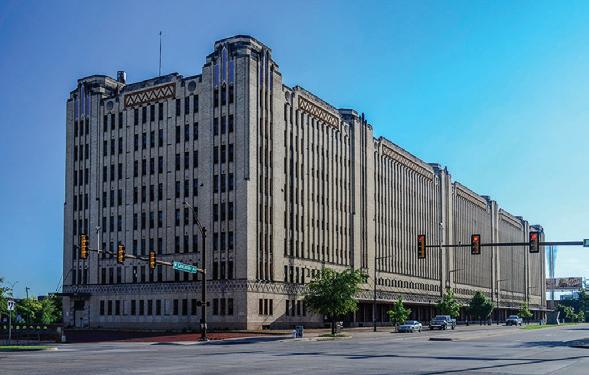
The Art Deco Texas & Pacific warehouse was designed by Wyatt C. Hedrick and constructed in 1931 as part of a three-building complex which included the Texas & Pacific Railway Terminal and US Post Office. The 500,000 square foot warehouse offered space for the storage and distribution of goods transported by the railroad, as well as offices and showrooms. The station shut down in 1967 when passenger service in Fort Worth ended, and the warehouse has since remained vacant. Though it was purchased by a private developer in 1997, no progress has yet been made toward rehabilitation.

Page 10
NORTH CENTRAL TEXAS 2023-2024
SAVING
WAYSIDE CHURCH AT TREZEVANT HILL
ADDRESS 2100 Beckham Pl, Fort Worth
DESIGNATION Highly Significant Endangered (Local)
CONDITION Fair
OWNER Wayside Church of God in Christ, Inc.
RESOURCE TYPE Religious
YEAR LISTED 2005
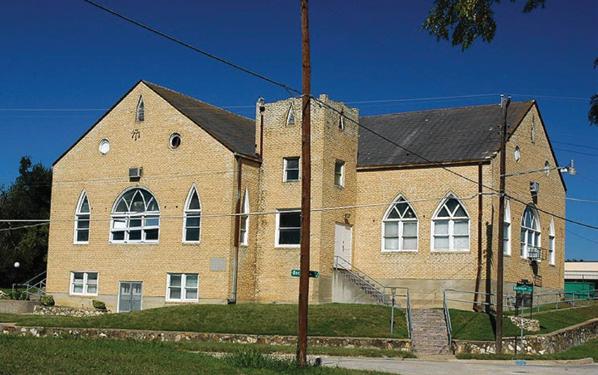
The Wayside Church is the last remaining building representing the early African-American community known as Trezevant Hill. The church was the site of the pioneering and historic African-American radio and television ministry of Bishop R.E. Ranger in the 1930s through the 1950s. Wayside Church is the site of the first national and international Black Gospel Radio Ministry in America, and is the oldest church of its denomination in Fort Worth. The church is threatened by encroaching Medical District development and lack of maintainence.
FARRINGTON FIELD & PUBLIC SCHOOLS GYMNASIUM
HISTORIC DISTRICT
ADDRESS 1501 University Dr & 1400 Foch St, Fort Worth
DESIGNATION NRHP District
CONDITION Good
OWNER Fort Worth ISD
RESOURCE TYPE Institutional
YEAR LISTED 2022

The Art Moderne Style Farrington Field stadium was constructed by WPA laborers in 1939, and it quickly became a popular venue for entertainment and recreation. In 1953, the Billingsley Field House and Gymnasium was constructed at the southeast corner of the property. The complex is a National Register Historic Disctric and the facilities remain in use by the school district today. However, Fort Worth ISD is considering selling the property which could lead to redevelopment of the site and demolition of the historic structures.
TAYLOR COUNTY
ABILENE COURTS
ADDRESS 633 S 11th St, Abilene
DESIGNATION NRHP
CONDITION In Progress
OWNER Abilene Preservation League
RESOURCE TYPE Commercial, Transportation
YEAR LISTED 2014
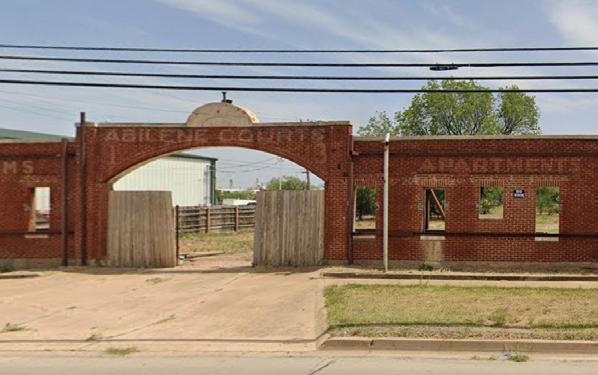
The Abilene Courts is a 1930s tourist accommodation typical of many similar places that have been lost along the historic Bankhead Highway, the earliest paved cross-country highway in America. The Abilene Courts represents an important era in automotive and architectural history in Texas and the United States. After sitting vacant for many years, the property was donated to the Abilene Preservation League (APL) in 2020. Years of neglect left the building vulnerable to the elements, resulting in significant damage. Though the bulk of the building had to be removed, the APL is determined to preserve the site.

SAVING NORTH CENTRAL TEXAS 2023-2024 PRESERVATION TEXAS Page 11
PRESERVATION TEXAS
WEST TEXAS UTILITIES POWER PLANT
ADDRESS E Hwy 80 and 100 Block N 2nd St, Abilene
DESIGNATION NRHP
CONDITION Fair
OWNER Private
RESOURCE TYPE Industrial YEAR LISTED 2022
SAVING NORTH CENTRAL TEXAS

Completed in 1922, this WTU Power Plant was designed by Fort Worth architect Wyatt C. Hedrick. The innovative design of the industrial space incorporated plentiful natural light, as well as a smokestack which remains a dominant feature of Abilene’s skyline. The plant served as a regional electricity provider until the 1960s, and helped shape the energy industry and economy of West Texas. The facility has remained vacant for several decades and is threatened by neglect.
WICHITA COUNTY BERRY BROWN HOUSE
ADDRESS 1400 Travis St, Wichita Falls
DESIGNATION Local Historic Landmark
CONDITION Poor
OWNER Private
RESOURCE TYPE Residential YEAR LISTED 2006
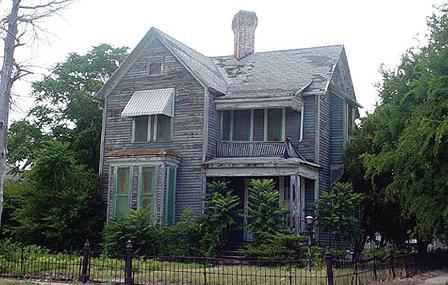
This two-story Victorian Style home built in 1892 is among the oldest remaining structures in Wichita Falls. Named for a 1940s City Alderman and previous owner, the house is believed to have been ordered from the Montgomery Ward catalog. The Wichita Falls Landmark sits on a corner lot lined with original wrought iron fencing. Having remained vacant for decades, the house is threatened by neglect and vandalism.
YOUNG COUNTY
1921 YOUNG COUNTY JAIL
ADDRESS 505 2nd St, Graham
DESIGNATION RTHL
CONDITION Fair
OWNER Young County
RESOURCE TYPE Municipal YEAR LISTED 2021

The former Young County Jail was constructed in 1921 and designed by Dallas-based architect C. H. Leinbach. The three-story brick structure was used as a jail until 1977 and is currently vacant. A recent proposal has called for ownership of the building to be transferred to the City of Graham so that it can be demolished and replaced with a pavilion celebrating the city’s 150th anniversary. The Young County Historical Commission is rallying support to preserve the three-story jail which has stood as a landmark in Graham for 100 years.

Page 12
2023-2024
Preservation Texas has also included the following statewide themes on its Most Endangered Places list to encourage Texans to identify threatened structures in their own communities that relate to the theme:
• Barns
• Carpenter Gothic Churches
• Cemeteries
• Civil Rights Sights
• Dams
• Dance Halls
• Gas Stations
• Historic Resources in City Parks
• Historic Resources of the Recent Past
• Historically Segregated Mexican-American Public Schools
• Iron Bridges
• Log Buildings
• Mid-Century Modern Sacred Places
• Painted Advertising Signs aka “Ghost Signs”
• Railroad Depots
• Rural African-American Heritage Sites
• Rural School Buildings
• Small Town Bank Buildings
• Small Town Municipal Buildings
• Small Town Theaters and Opera Houses
• Working Class Neighborhoods
1201 E Division St, Arlington
2006 Most Endangered Places List

This large Georgian Revival facility was constructed in 1924 to serve as a home for aged and infirm members of the Eastern Star Organization in Texas. Additions to the building in 1931, 1954 and 1966 provided a kitchen, an enlarged dining room, a new east wing and a hospital unit. In April of 2013, the Eastern Star Home was demolished to make way for new development surrounding the AT&T Stadium.

SAVING NORTH CENTRAL TEXAS 2023-2024 PRESERVATION TEXAS Page 13
TARRANT COUNTY EASTERN STAR HOME
LOST NORTH CENTRAL TEXAS ENDANGERED PLACES
THEMATIC LISTINGS
SAVED NORTH CENTRAL TEXAS ENDANGERED PLACES
COLEMAN COUNTY
FIRST CHRISTIAN CHURCH
508 Ave C, Santa Anna
2008 Most Endangered Places List
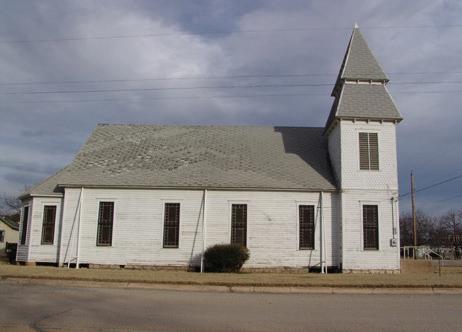

COMANCHE COUNTY
ST. LOUIS & SAN FRANCISCO
RAILWAY DEPOT
304 S Austin St, Comanche
2007 Most Endangered Places List
EASTLAND COUNTY
LAGUNA HOTEL
400 Conrad Hilton Blvd, Cisco
2015 Most Endangered Places List
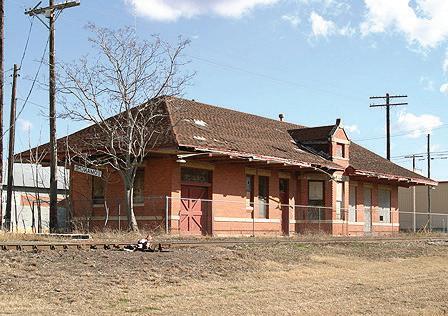



HOOD COUNTY
BRAZOS DRIVE-IN THEATER
1800 W Pearl St, Granbury
2010 Most Endangered Places List




Page 14
NORTH CENTRAL TEXAS 2023-2024
TEXAS
SAVING
PRESERVATION
PRESERVATION TEXAS IS THE ADVOCATE FOR THE HISTORIC AND CULTURAL RESOURCES OF TEXAS.


This publication has been made possible by the generous support of PreservationTexas.org
Follow us!


@PreservationTexas
































